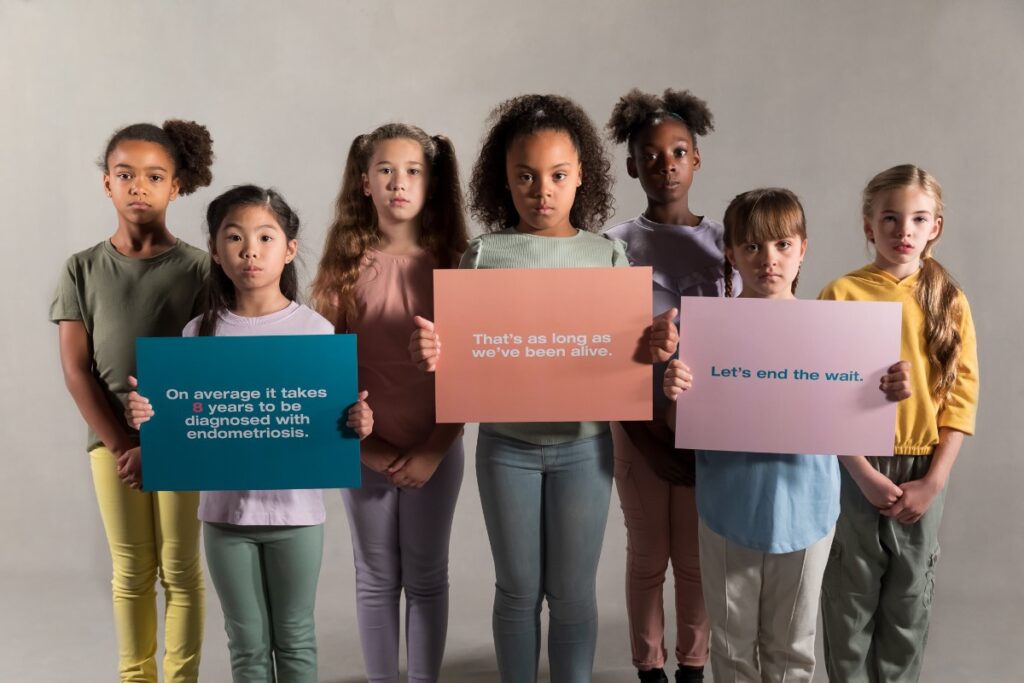EIGHT-YEAR-OLD CHILDREN SYMBOLISE THE SHOCKING EIGHT YEAR WAIT FOR AN ENDOMETRIOSIS DIAGNOSIS IN MENSTRUAL HEALTH CAMPAIGN

One in 10 women worldwide have endometriosis1, yet despite the seriousness of this disease, it takes an average of eight years just to get a diagnosis2. That’s eight long years of enduring terrible pain and the feeling of not being heard.
Today, to give a voice to those suffering from the condition, intimate wellness brand INTIMINA has released a powerful film that features eight-year-old children whose age symbolises the damning eight-year wait statistic – with each of the youngsters having been alive for as long as it takes to be diagnosed with endometriosis*.
Endometriosis is a long-term condition where tissue similar to the lining of the womb grows in other places, such as the ovaries and fallopian tubes.
What’s more, with this devastating disease commonly starting in adolescence (and sometimes before) any of the eight-year-olds in the film – and across the world – could develop endometriosis in the near future and face the eight year delay themselves if nothing is done to shorten the time to a diagnosis.
In the film, the children speak the actual words of real adult women who spent years of their lives waiting and fighting for an endometriosis diagnosis. While the average wait for a diagnosis is eight years, several of the women that shared their stories experienced delays of much longer. In one instance, it took a shocking 30 years for a woman to finally be told she had endometriosis. The film can be viewed here: https://www.youtube.com/watch?v=L6Rz9A6EyG8
Selected cases from UK-based women that faced ‘the wait’ and whose accounts are spoken by eight-year-old children in the film:
Katie Beales (waited nine years) “Waiting years for a diagnosis made me question my own sanity. At points, I started to believe that it was all in my head. I had so much ambition and this condition took so much away from me. The pain was so bad I couldn’t leave my bed, I would vomit and I couldn’t eat. I became a shell of myself. Endometriosis is lonely. It changed my identity.”
Nadine Lewis (waited 12 years): It took me five years to get my stage four diagnosis and a further seven years to be diagnosed with thoracic endometriosis. I often feel trapped inside my body which is constantly under attack. I have had countless A&E admissions, investigations and surgeries and been medically gaslighted. I had three diagnostic laparoscopies with no endometriosis removed. Endometriosis has affected my mental health, fertility, bowel and respiratory health. No one should have to go through this. It should not take this long to be taken seriously.”
Aisha Balesaria (waited 15 years): At 15 I had started experiencing dreadful pain during menstruation – pain which grew worse as the years went on. It was tremendously difficult waking up in pain and going to bed in pain and doing the same thing all over again the next day. The pain was so intense, it left me confined to my bed. At some points I felt I couldn’t carry on living with the excruciating pain. The pain I was experiencing was dismissed as ‘bad periods’. I felt completely helpless and hopeless. It was extremely challenging waiting for someone to believe me and over time my symptoms worsened. It would be many years later before I’d receive the correct diagnosis. I felt there was little empathy towards my suffering during the years I tried to get help, and my symptoms were downplayed nearly all of the time.”
INTIMINA created ‘The Wait’ film as part of its ongoing Seen + Heard period positivity campaign. Seen + Heard aims to increase the visibility of menstrual wellbeing across the world, normalise conversations about menstrual health, tackle stigma and bias and raise awareness of conditions like endometriosis – which see millions of people suffering in pain while their voices go unheard. The Wait follows ‘Period’: a collaboration in 2020 between INTIMINA and Pantone that saw the creation of a shade of red emblematic of a healthy menstrual flow.
Marcella Zanchi, Spokesperson for INTIMINA, commented: “We hope this film, in which the age of the eight-year-olds symbolises the eight-year wait for a diagnosis, can create much-needed conversations about endometriosis and inspire change. Because it is unacceptable that people have to wait eight years just to get help. And it’s important to remember that is only an average: some people wait many more years, even decades of their lives in pain.
Zanchi continued: “Endometriosis isn’t a rare disease – it affects one in every 10 women. That’s hundreds of millions of people across the world potentially suffering for years. The fact the eight-year statistic hasn’t changed in over a decade is further proof, if it were needed, that we must end the wait for those with endometriosis. As a global society we have to be more aware of endometriosis, more sympathetic towards those that have it, to speak up and do everything in our collective power to close the gender health gap and to break the taboos and biases that are not just attached to endometriosis, but to menstrual wellbeing in general.”
A UK All Party Parliamentary Group Endometriosis inquiry into the disease surveyed over 10,000 people with endometriosis and found that over half (58%) visited their GP more than 10 times after presenting symptoms, but still no diagnosis was made3.
Further commenting on reasons behind the eight-year wait, INTIMINA UK Expert Gynaecologist Dr Shree Datta said: “Healthcare professionals may assume painful periods are normal, if they are unclear on its severity and whether pain relief is required. What’s more, it can be especially difficult examining young teenagers for endometriosis as the findings are not specific and the disease presents differently from person-to-person. As such it may take longer to refer people to the correct specialist for further investigation and treatment. From a patient perspective it can also be uncomfortable taking that first step and speaking to a doctor about issues such as pain during sex – or challenging to describe the symptoms they have.”
Shree continued: “The reasons behind the delay are wide-ranging, but nevertheless every possible action needs to be taken to drive down the wait time for people suffering with endometriosis, and education and awareness is vital to make a commitment to ensure this happens.”
To help people experiencing symptoms of endometriosis get the help they need sooner, Dr Shree Datta shares her advice. More information and resources can be found here: https://www.intimina.com/blog/talk-about-endometriosis/




